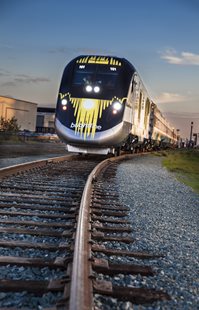Even if new stations generate traffic that could be a nuisance, local communities along Brightline’s Los Angeles-to-Las Vegas route hope that the train will come with significant benefits.
 For as much as Las Vegas has grown in the past four decades, Brightline grabbed a 110-acre undeveloped parcel for its terminus. Local officials say the area is ripe for development, and the company’s renderings portray a sprawling mixed-use complex that overwhelms the train station itself, which, according to Ben Porritt, Brightline’s senior vice president for corporate affairs, will occupy only 35 of those acres.
For as much as Las Vegas has grown in the past four decades, Brightline grabbed a 110-acre undeveloped parcel for its terminus. Local officials say the area is ripe for development, and the company’s renderings portray a sprawling mixed-use complex that overwhelms the train station itself, which, according to Ben Porritt, Brightline’s senior vice president for corporate affairs, will occupy only 35 of those acres.
“It’s all fine and good to have a train that connects some big cities, but the successful systems of the world are supported by dense station area development, within a half-mile or more of the station,” said Eric Eidlin, research associate at the Mineta Institute of Transportation.
Porrit said the company has already witnessed this along its Florida rail line.
“We’ve seen in South Florida an increase in transit-oriented development (TOD), people wanting to be around the train,” he said. “We think you’re going to see the same thing in the Las Vegas region.”
The train might inspire some new urban forms in Las Vegas, which has generally embraced low-density sprawl and monumental hotel-casinos, with little in between. Brightline itself is well positioned to capitalize on development oriented to its station.
 “It’s a really good opportunity to do some unique and interesting development, create a space that’s walkable and commutable. It’s the best opportunity we have for a real multimodal, mixed-use project,” said Clark County Commissioner Michael Naft. “There isn’t anywhere else in the state that has anywhere close to the contiguous acreage of developable land, certainly not with a Las Vegas Boulevard address.”
“It’s a really good opportunity to do some unique and interesting development, create a space that’s walkable and commutable. It’s the best opportunity we have for a real multimodal, mixed-use project,” said Clark County Commissioner Michael Naft. “There isn’t anywhere else in the state that has anywhere close to the contiguous acreage of developable land, certainly not with a Las Vegas Boulevard address.”
At the other end of the line, the cities of Apple Valley and Rancho Cucamonga have various versions of TOD in mind.
Even before Brightline seemed viable, Rancho Cucamonga rezoned the area around its Metrolink station for higher density, relative to the city’s predominant typology of single-family homes. The zoning accommodates up to 3,000 homes, and the addition of Brightline could make the area even more appealing to developers.
“Since we had a train station there, we wanted to take advantage of a redevelopment opportunity,” said Rancho Cucamonga Assistant City Manager Matt Burris.
The Apple Valley station will be located in what is essentially empty desert, well beyond Apple Valley’s current urban fringe and beyond the reach of the city’s water and power lines, among other basic infrastructure. City planners say that the Brightline station may provide the impetus for developers to pay for the infrastructure and essentially open up the entire quadrant of the city to development.
Josh Stephens is a freelance writer based in Los Angeles.